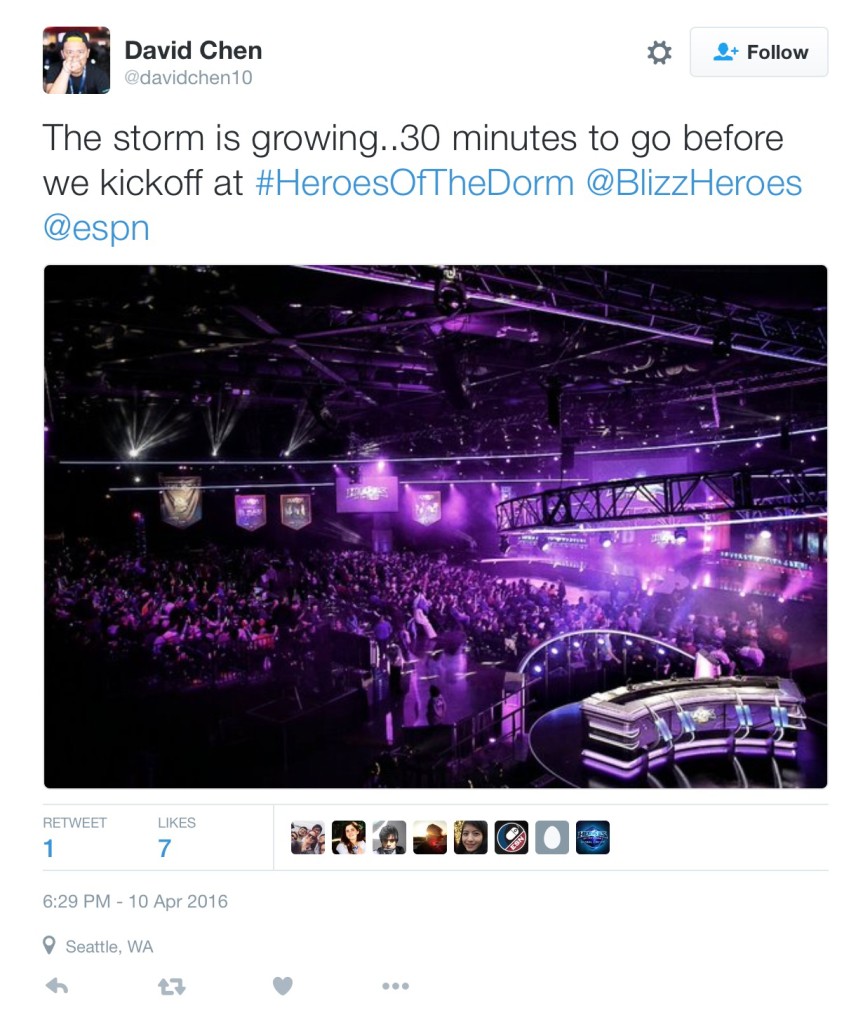The following is a guest blog post by my colleague Aaron Blackman, who in addition to being a forensics coach and comm lecturer is also a big fan of video and tabletop games.
For the second year in a row, ESPN decided to forego showing traditional physical sports during primetime on a Sunday night. Rather than watch the Golden State Warriors tie the NBA record for number of wins in a season, many viewers (myself included) chose to watch 10 college students duke it out in a PC game for a chance at free college tuition. On April 10th, ESPN2 showcased eSports by airing the live Grand Final round of the Heroes of the Dorm tournament. The tournament began with over 400 teams from Universities across the country, and ended with students from Arizona State University winning up to $75,000 each in tuition for the rest of their college careers.
 Heroes of the Dorm is a playful name twist on the video game that was being played in the tournament: Heroes of the Storm. Released on June 2nd, 2015 by Blizzard Entertainment, Heroes of the Storm is is a Multiplayer Online Battle Arena (MOBA) similar to other popular titles like DoTA2 and League of Legends.
Heroes of the Dorm is a playful name twist on the video game that was being played in the tournament: Heroes of the Storm. Released on June 2nd, 2015 by Blizzard Entertainment, Heroes of the Storm is is a Multiplayer Online Battle Arena (MOBA) similar to other popular titles like DoTA2 and League of Legends.
The concept beyond a MOBA is simple: two teams of 5 players square off in a digital battle to destroy the opposing team’s base. Each player chooses a hero that complements their team and levels up during the course of the match. The players try to sway the course of the battle by destroying enemy fortifications as well as fighting the other team – all in a bid to reach the enemy HQ, the core.
Whereas matches in other MOBA’s typically last 30-45 minutes, Heroes of the Storm tries to cater to a more casual audience with matches that last around 15-20 minutes. In addition, players can choose from the ever growing list of 50 possible heroes to play as, all of which are established characters from popular Blizzard video games such as Warcraft, Starcraft, and Diablo.
So why exactly does ESPN air the end of a video game tournament on a Sunday night? Just last week, Fortune reported on Newzoo, a research firm that analyzed eSports and the main place fans turn to for watching them: Twitch.tv. According to Newzoo, 475.5 million hours of eSports content was viewed on Twitch from July to December in 2015 alone. Newzoo also forecasts that eSports will grow to be a $765 million industry by 2018.
ESPN certainly seems interested in cashing in on a growing phenomenon, and have a dedicated eSports news page. However, without a consistent schedule or dedicated channel, ESPN’s attempts to cover eSports seem half-hearted. The dissonance caused by watching an eSport on ESPN, while physical sports scores tracked along the bottom of the screen was jarring.
Esports playing on ESPN2, while traditional physical sports scores are ticking across the bottom. This is a sight. #HeroesOfTheDorm
— Aaron Blackman (@acblackman) April 11, 2016
I spent a few hours watching and tweeting Saturday night during the Semifinal round, as well as Sunday for the Grand Finals. Following the hashtag #HeroesoftheDorm, I ended up making a few observations. First, there were outliers on both ends of the spectrum for ESPN2 airing a video game tournament. Video game fans used to watching free streams on Twitch were disheartened that a cable subscription was required to watch on Saturday and Sunday.
On the other side of the argument, sports fans were upset that video games were being aired in the first place.
Let me get this straight. Spurs vs. Warriors is on NBAtv but I'm watching college kids play Nintendo on ESPN2. Good stuff ESPN.
— joetease (@joetease) April 11, 2016
Second, ESPN pulled off a delicate balance between informing newcomers and satisfying gamers. Fans had a hard time getting used to a watered down version of the on-screen scoreboard.
Not wild about this observer overlay for #HeroesOfTheDorm. We lost the kills stat, and the talent picks. @HeroesEsports @BlizzHeroes
— Aaron Blackman (@acblackman) April 10, 2016
ESPN had to make the information accessible to viewers who have never watched eSports before, but at the cost of leaving gamers in the dark on key statistics. The organizers clearly explained the video game in a very basic way each night, but only at the beginning of the broadcasts.
ESPN has staked its interest in a rapidly growing industry, but only time will tell if they can work out the kinks on airing video games alongside sports.
ASU is consistently better at setting up team fights and catching someone out of position. Last night and tonight. #HeroesOfTheDorm
— Aaron Blackman (@acblackman) April 11, 2016
1 (Good photo of the venue for the Grand Finals)

Pingback: HOtS Replay Analysis #1 | Aaron's Video Game Blog